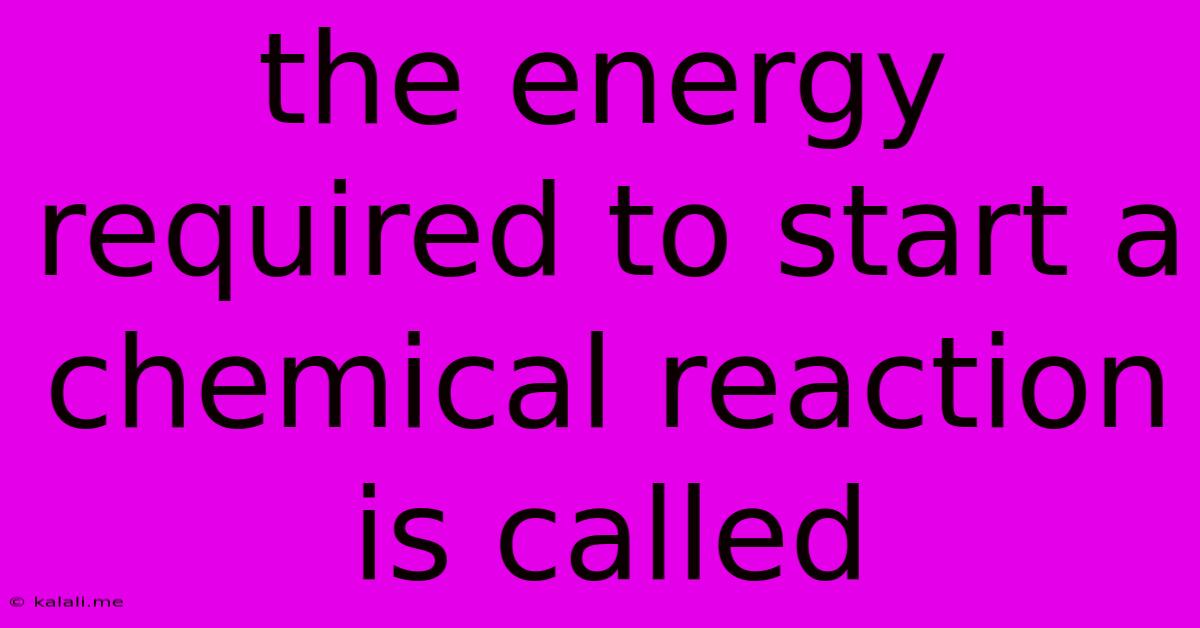The Energy Required To Start A Chemical Reaction Is Called
Kalali
May 10, 2025 · 3 min read

Table of Contents
The Energy Required to Start a Chemical Reaction: Understanding Activation Energy
The energy required to initiate a chemical reaction is called activation energy. This crucial concept explains why many reactions, even highly exothermic ones (releasing energy), don't spontaneously occur. Understanding activation energy is key to comprehending reaction rates and the role of catalysts. This article will delve into the intricacies of activation energy, exploring its definition, factors influencing it, and its practical applications.
What is Activation Energy?
Activation energy (Ea) is the minimum amount of energy needed for a chemical reaction to proceed. It represents the energy barrier that reactant molecules must overcome to transform into products. Think of it like pushing a boulder uphill – you need a certain amount of energy to get it over the crest before it can roll down the other side. In a chemical reaction, this "crest" represents the transition state, an unstable, high-energy intermediate stage between reactants and products.
Molecules possess kinetic energy due to their constant motion. For a reaction to occur, colliding molecules must possess a combined kinetic energy equal to or greater than the activation energy. Only then can they successfully navigate the energy barrier and form products. Reactions with high activation energies proceed slowly, while those with low activation energies proceed rapidly.
Factors Affecting Activation Energy
Several factors can influence the magnitude of activation energy:
-
Nature of Reactants: The inherent chemical properties of the reactants significantly impact the activation energy. Stronger bonds require more energy to break, leading to a higher activation energy.
-
Reaction Mechanism: The specific pathway a reaction follows (its mechanism) influences the activation energy. A reaction proceeding via multiple steps will generally have a lower activation energy than a one-step reaction. This is because each step involves a lower energy barrier.
-
Temperature: Increasing temperature increases the average kinetic energy of molecules. A higher proportion of molecules then possess sufficient energy to overcome the activation energy barrier, leading to a faster reaction rate.
-
Presence of a Catalyst: Catalysts are substances that accelerate reaction rates without being consumed. They achieve this by providing an alternative reaction pathway with a lower activation energy. This means fewer molecules need to reach the higher energy threshold to react. Enzymes are biological catalysts that play crucial roles in living organisms. They significantly lower the activation energy for many biochemical reactions, making them occur at biologically relevant rates.
Activation Energy and Reaction Rates
The relationship between activation energy and reaction rate is inverse and exponential. A higher activation energy means a slower reaction rate, and vice-versa. This relationship is quantified by the Arrhenius equation, which shows how the rate constant of a reaction depends on the activation energy, temperature, and other factors.
Practical Applications
The concept of activation energy has numerous practical applications, including:
-
Industrial Chemistry: Understanding activation energy is crucial for optimizing industrial chemical processes by controlling reaction temperature, pressure, and catalyst use to achieve desired reaction rates.
-
Pharmacology: Drug design often involves manipulating activation energies to enhance the effectiveness of drugs or inhibit harmful reactions.
-
Materials Science: Activation energy is important for understanding the kinetics of material formation and degradation.
In conclusion, activation energy is a fundamental concept in chemistry that governs the rate of chemical reactions. By understanding the factors influencing activation energy, we can better control and manipulate reaction rates, with significant implications across various scientific and technological fields. Further research in this area continues to refine our understanding and provide new avenues for innovation.
Latest Posts
Latest Posts
-
What Year Would I Be Born If I Was 17
Jul 15, 2025
-
What Is Longer A Kilometer Or A Mile
Jul 15, 2025
-
How Much Does A Full 15 Lb Propane Tank Weigh
Jul 15, 2025
-
Did Chester Wear A Brace On Gunsmoke
Jul 15, 2025
-
How Many Mikes Hard To Get Drunk
Jul 15, 2025
Related Post
Thank you for visiting our website which covers about The Energy Required To Start A Chemical Reaction Is Called . We hope the information provided has been useful to you. Feel free to contact us if you have any questions or need further assistance. See you next time and don't miss to bookmark.